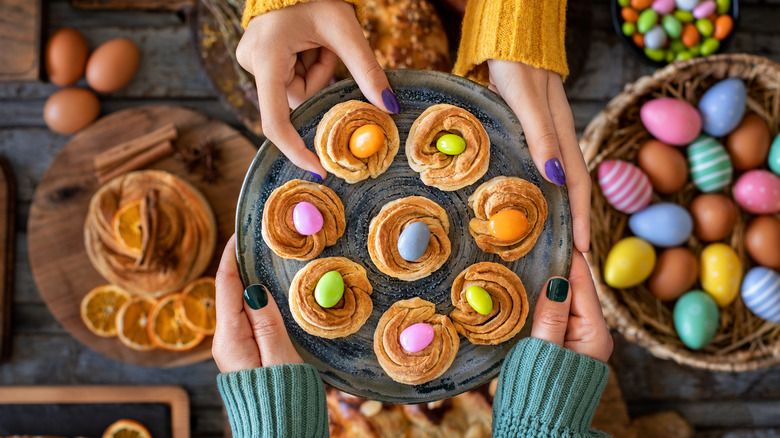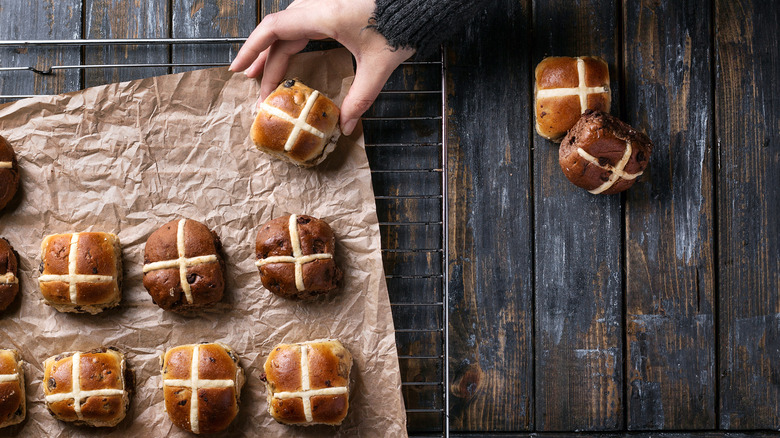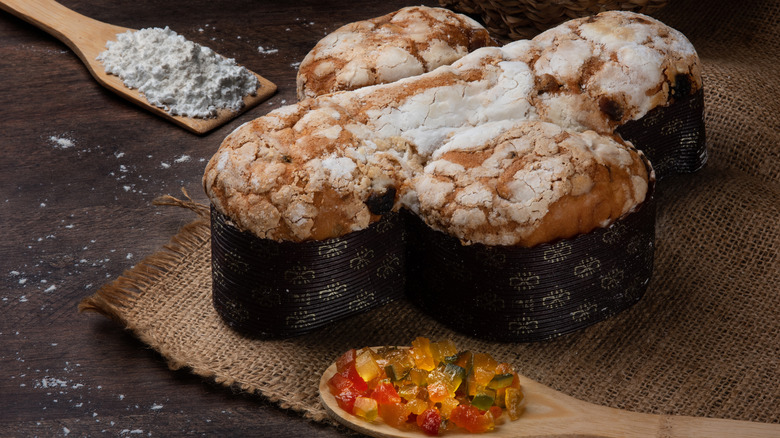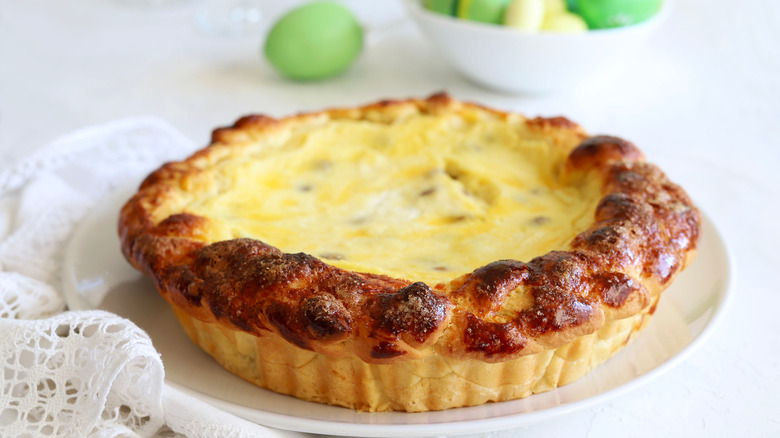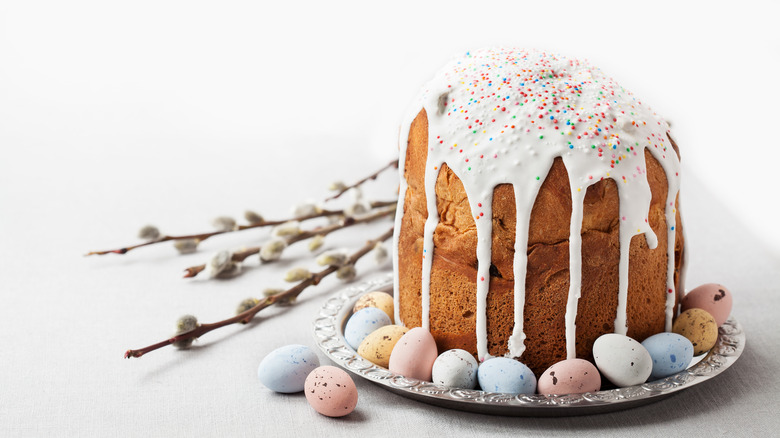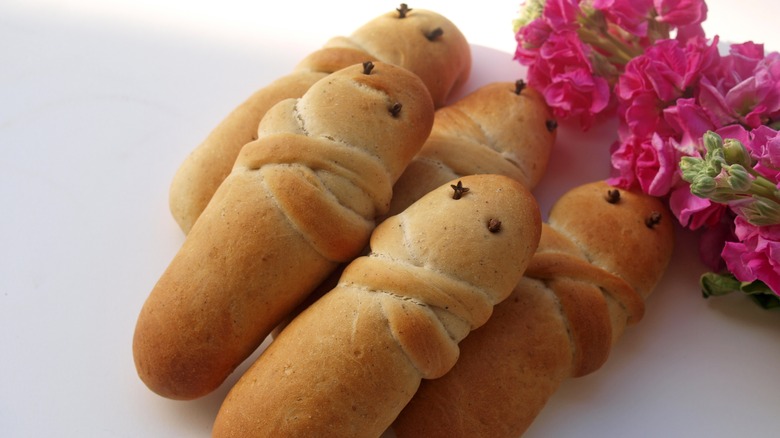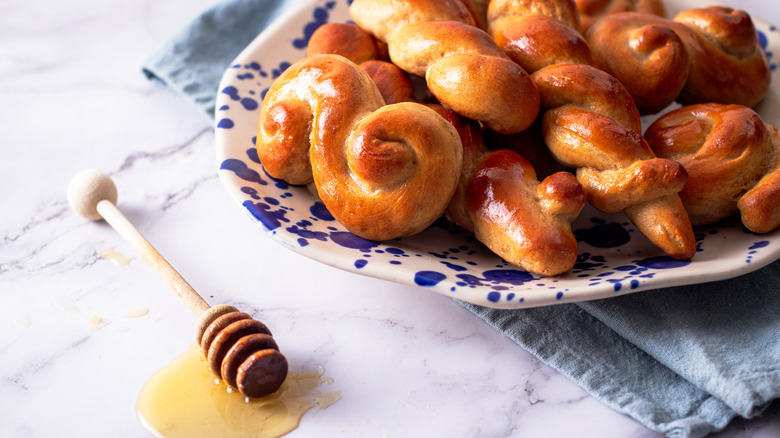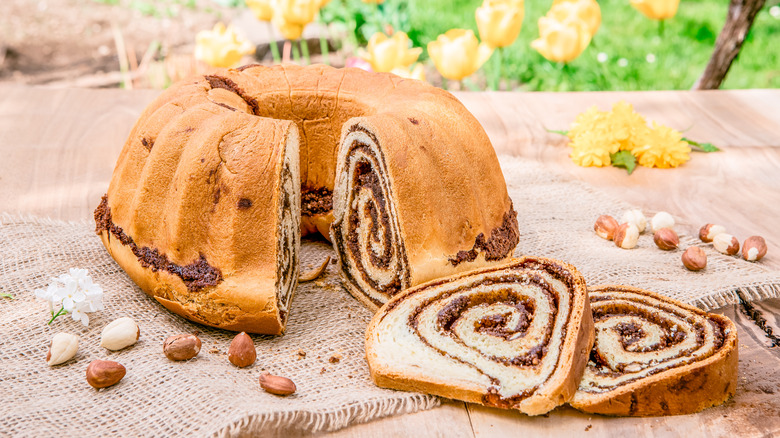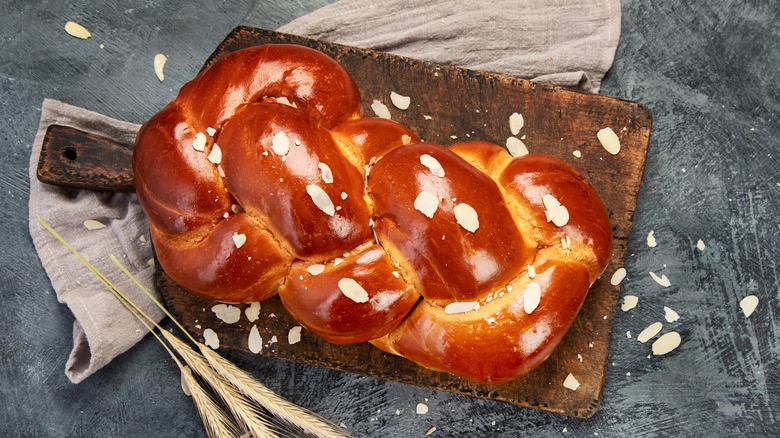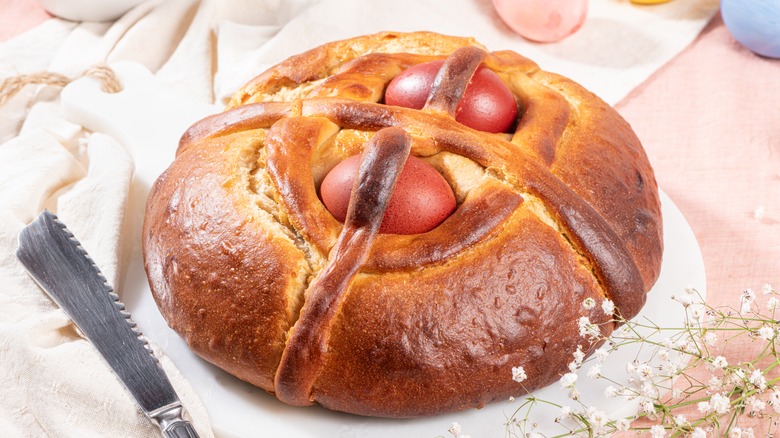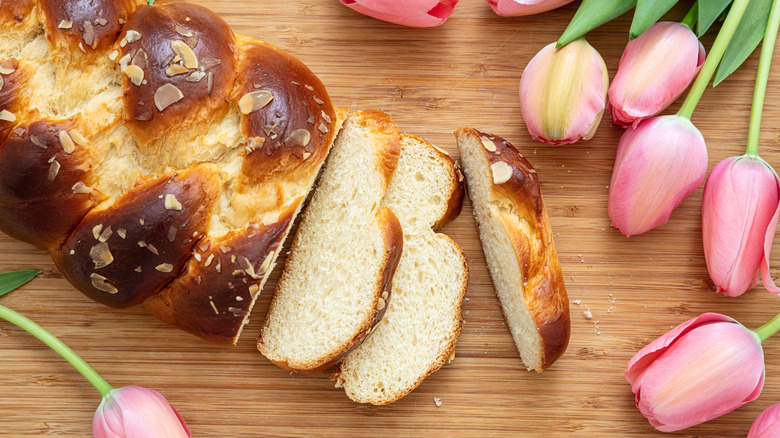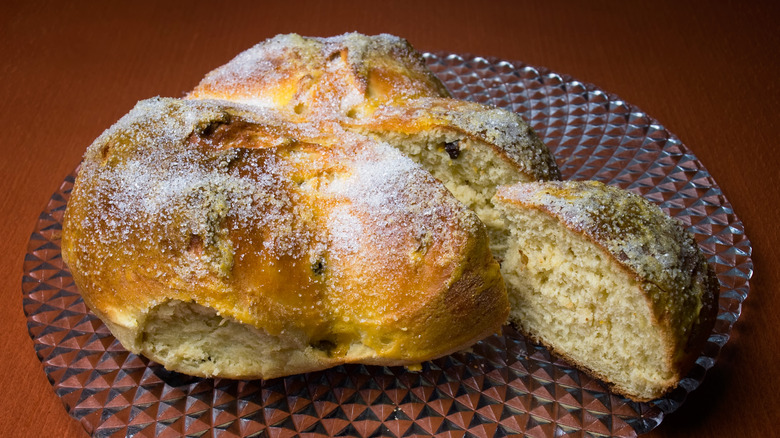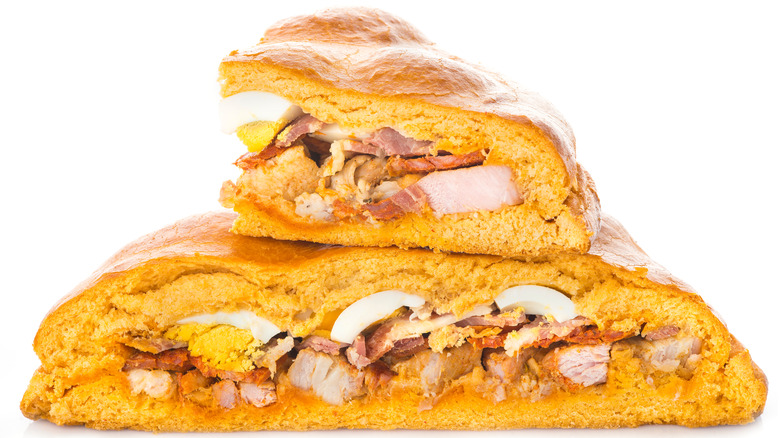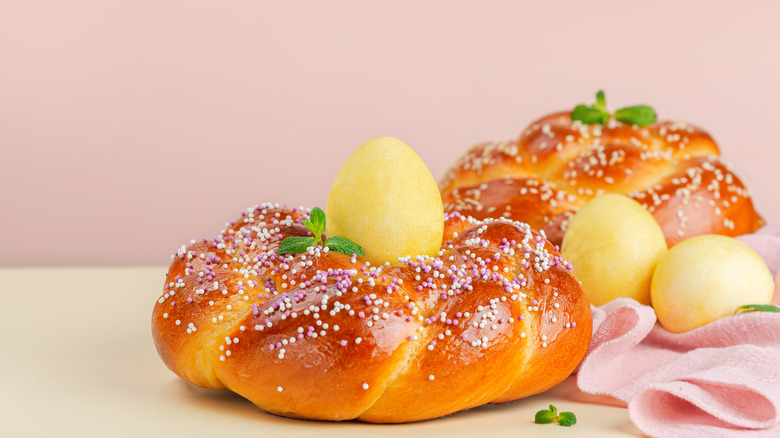What Easter Bread Looks Like Around The World
Easter is a holiday steeped in religious symbolism, and this is apparent in the traditional food eaten to commemorate the event. This symbolism can be seen in the crosses incised on the bread or the clever use of dough shaped and twisted to mimic religious motifs. However, not all these traditions stem from Christianity; many have roots in ancient pagan rituals celebrating spring as the time of rebirth and awakening. The two approaches eventually blended to create a medley of culinary customs that we now associate with Easter.
One of the prevalent European Easter traditions is baking an intricately decorated yeasted bread that becomes the focal point of every Easter meal. Most of them are sweet and start as a brioche-like dough incorporating copious amounts of butter and eggs. The richness of these loaves serves as an antidote to the preceding 40-day Lent, during which people usually refrain from eating meat, eggs, fat, or any food that evoked richness and luxury.
Each Easter bread on the list speaks of regional culinary heritage and can be used as an inspiration for your baking endeavors. These aromatic, golden-colored loaves will easily take the spot as the most decorative part of the festive Easter table.
Hot cross buns – United Kingdom
Hot cross buns are round yeasted bread rolls easily distinguished by a cross sign nestled on top of each piece. These buttery buns are always spiced, traditionally with warming winter spices such as cinnamon, cloves, and nutmeg, and come packed with sultanas and dry currants. Besides the traditional version, flavor combinations are virtually endless, and the buns work well with chocolate, caramel, and citrus flavors and can be studded with any dry fruit that you prefer. The cross is made with a flour paste, leftover dough, or sugar icing, while the top is usually coated in a glossy egg glaze.
No one knows for sure when and where hot cross buns originated, but by the 18th century, they were already referenced in literature. While some believe that they originate from pagan traditions, others think that a 14th-century monk from St Albans Abbey first whipped up a spiced roll that was later used as a model for hot cross buns.
Hot cross buns are best enjoyed sliced and toasted, but feel free to enjoy them as is. Ideally, you would generously smother them with butter, but these subtly sweet and aromatic rolls can work well with any sweet or even savory spreads and fillings. Because of their size, they are an ideal single-serving option. Though they are an Easter staple traditionally eaten on Good Friday, hot cross buns are not a holiday exclusive, and you can enjoy them as a year-round treat.
Colomba di Pasqua – Italy
Among many Italian Easter breads, colomba is probably the most popular variety. It may have something to do with its wonderful flavor and incredibly light texture, but it is also the most recognizable version due to its pretty hefty size and distinct dove-like shape. Colomba is made with a sweet, leavened dough enriched with eggs and butter. The top is usually covered in a thin layer of sugary frosting and almonds.
The history of Easter colomba started in the early 20th century when local Milanese confectioners decided to make a rich yeasted cake that would be an Easter exclusive. The idea was to create an equivalent to the already famous pandoro and panettone, which were mainly reserved for Christmas. The dough mimics the one found in classic Christmas bread, but the shape was allegedly inspired by ancient medieval legends where doves and dove-shaped loaves had prominent roles, though no one knows which particular story was used as an inspiration.
Traditional colomba is garnished with whole almonds dispersed over the sugary coating. Classic colomba is flavored with candied oranges, but modern versions often incorporate slightly less traditional but not less Italian extras such as hazelnut spread, amarena cherries, or pistachio cream.
Pască – Romania
Falling somewhere between a cake and sweet bread, pască is best described as a traditional Romanian take on a cheesecake. This springtime favorite consists of a bready shell holding a generous amount of flavorful cheese filling. The base is made with leavened, brioche-like dough that is braided and wrapped as a decorative round mold that shelters the filling. The cheese inside the cake is usually fresh cow's milk cheese that is sweetened and enriched with sour cream, eggs, vanilla, and raisins. However, modern versions tend to diverge from the original to add less traditional ingredients, as the cake can be a great blank canvas to play with additional flavors. Baked until golden, this cheesecake resembles the bright sun and is the perfect addition to the festive Easter table.
Pască is now a staple on Romanian Easter feasts, but its origin and its relationship with Orthodox Easter are hard to explain with certainty. The most obvious explanation is that the vibrant yellow filling and golden-hued crust symbolize rebirth and resurrection. This sweet cheesy bread is usually taken to church to be blessed by a priest and is then shared among family members on Easter Sunday.
Paska – Ukraine
Though they share a similar name, Ukrainian paska doesn't have much in common with the cheese-packed Romanian version that is reminiscent of an open faced pie. This traditional Easter bread of Ukrainian origin resembles a classic brioche made with yeasted dough enriched with eggs and butter. It can be infused with rum, vanilla, and citrus zest, and you can have it plain or stuffed with fruit. Paska is a round bread that often has a tall, cylindrical shape, though it can vary in height and size. Old-school paska is mainly garnished with intricate dough ornaments, whereas contemporary versions often come doused in icing that generously drips on the sides.
Paska's origin predates Christianity, but this aromatic bread is now closely related to Easter. It is usually brought to church for a blessing and is then shared among family members on Easter Sunday. Kulich is a similar Russian version of this festive cake.
Lazarakia – Greece
Perhaps the most unusual addition to the list — in terms of the ingredients and the appearance — are lazarakia rolls that hail from Greece and Cyprus. Unlike most items on the list, these rolls are prepared and enjoyed before Easter, typically on Lazarus Saturday, which precedes the Holy Week. As they're served during Lent, lazarakia won't incorporate eggs, butter, and milk. Instead, the dough will be a simple mix of flour, sugar, oil, yeast, and water. In most cases, the base is generously flavored with warming spices, while dry fruit, nuts, or honey can be used to improve the texture and flavor.
Lazarikia rolls are easily distinguished by their unusual shape. Each piece is skillfully folded to resemble a person wrapped in burial cloth. This distinctive shape is a reference to Lazarus, a biblical character resurrected by Jesus who was the inspiration for these unusual bread rolls. A finishing touch to each roll is the addition of raisins or cloves that are neatly positioned to mimic eyes, giving the bread a more realistic, and perhaps slightly disturbing, feel.
Jidáše or Judas bun – Czech Republic
Jidáše are small pastry knots of Czech origin traditionally enjoyed on Holy Thursday. Like most Easter treats, these rolls start with a dough that is similar to a classic brioche. Along with flour, yeast, and milk, it incorporates sugar, butter, and eggs to create a sweet, leavened base that will bake into a delicate sweet pastry. Each coil is glazed with honey to get a nice, glossy finish and a touch of sweetness, but honey glaze also has a symbolic role. According to the old folk belief, it will protect anyone who consumes the buns from poisoning and snake bites.
Jidáše can be roughly translated as Judas buns, which is a reference to Judas the apostle, who is best known for betraying Jesus, an act which eventually led to his crucifixion. It is said that the thin strip of dough is supposed to resemble the rope Judas used to take his own life. Despite their grim origin, these bread rolls will be a sweet and pleasant surprise to your tastebuds.
Potica – Slovenia
Potica is one of the most famous traditional Slovenian specialties with a history that dates back to the 16th century. Initially only made for Easter and other festive occasions, this rich nutty roll is now a staple dessert that is not restricted by seasons or special events. Though it is now enjoyed throughout the year, potica still makes a regular appearance for Easter, as it's considered that no festive meal is complete without a slice of this traditional nut roll.
Potica is made with a butter-rich, leavened dough and can consist of various sweet and savory fillings, though the latter are less common. Walnut filling — sweetened and enriched with spices and a splash of liquor — is the most popular version, followed by cheese, poppy seeds, and hazelnuts. Potica is filled, rolled in a coil, and then baked in a specially designed, traditional baking dish resembling a classic bundt mold. When you break into it, you should see a perfect swirl and an ideal dough-to-filling ratio.
Potica is one of numerous nut roll varieties that are found in central and eastern Europe. Similar versions are found in Austria, Hungary, and across the Balkans. All these versions were once reserved for special occasions, but they are now easily available year-round, though you will never see a festive table without one of these captivating rolls.
Tsoureki – Greece
Tsoureki is the ultimate showstopper, a glossy Greek bread served as an indispensable part of every Easter meal. Made with a soft, leavened dough, it is an incredibly light buttery loaf covered in a thin golden crust. It is usually formed in a rolled or elongated braid that symbolizes the Holy Trinity. Tsoureki is stunning enough to be served plain, but you will sometimes see it garnished with slivered almonds, and — as a true sign of its Easter origin — the loaves will often be decorated with vibrant red-dyed eggs.
Tsoureki uses the same yeasted, butter-enriched dough but also incorporates mastic and mahleb, two components that deliver a distinct flavor. Mastic is the minty and herbaceous sap of the eponymous tree that usually comes from the island of Chios, and mahleb is a powdery spice made with ground cherries that lends a subtly bitter, almost marzipan note to tsoureki.
Tsoureki is usually eaten on Easter Sunday, and though you can eat it at is, it makes an excellent partner with butter or fruit jams.
Folar – Portugal
Folar is the traditional bread prepared and enjoyed during Easter festivities in Portugal. But this Easter bread is not consistent and uniform throughout the country. It can vary in flavor, size, and form, mostly depending on the region where it originated. The most common version is a subtly sweet, spiced bread made with leavened dough and decorated with dyed boiled eggs cozily tucked inside the dough. Strips of dough are also used to shape a cross that stretches across the surface of the bread. Typical flavors you will find in the Easter folar are cinnamon and aniseed (fennel), but the choice can vary depending on the type of bread.
The origin of this Easter bread is shrouded in mystery and folk tales, but the tradition suggests that godchildren should bring bouquets of delicate spring violets to their godparents, and in return, they get the freshly baked Easter folar.
Kozunak – Bulgaria
Kozunak is a classic Bulgarian Easter bread. Made with enriched, buttery dough, the loaf is usually braided and glazed to attain golden colored crust that protects the soft and tender center of the bread. Kozunak is sometimes garnished with slivered almonds, and though it is often made plain, versions studded with dry fruit or nuts are commonly found these days. Apart from eggs and butter, this sweet bread will derive flavor from citrus zest, but rum (which can also be great for soaking raisins), vanilla, and other spices, can be added for some aromatic boost.
Bulgarian kozunak is often mistaken for cozonac, a similar leavened bread from Romania that is not strictly related to Easter. Though it uses a comparable brioche-like dough, cozonac typically incorporates weighty walnut or poppy fillings. The shape is also different and has more in common with chocolate or cinnamon babka than with a classic Bulgarian kozunak.
Pinca – Croatia
Pinca is a sweet, leavened bread that graces Easter tables in many Croatian households. The bread is made with butter-rich dough flavored with vanilla and lemon zest. Occasionally, rosewater and rum are added to the mix, and the bread is sometimes dotted with soaked raisins or other dry fruit. Pinca is shaped into round loaves, and each is incised with a cross that gives the bread a distinctive star-like shape. The loaves are glazed and often garnished with crunchy sugar that counterbalances all the buttery richness in the bread.
Pinca is a sweet bread, but you will frequently see it served with savory ingredients, such as boiled eggs, radishes, and spring onions, which are all part of the standard Easter Sunday breakfast. Of course, this doesn't mean that pinca can't work well with sweet jams and spreads, but perhaps it shows its full potential when paired with coffee or tea as an ideal afternoon pick-me-up.
Somewhat confusingly, this Easter bread is also known as sirnica — which derives from the Croatian term for cheese — but the bread never has any cheese inside the dough, and it's not entirely clear how this alternative name originated.
Hornazo – Spain
Hornazo is one of the rare items on this list that is exclusively savory and has no sweet counterpart. Best described as a variety of stuffed bread or a hearty pie, this Easter treat hails from Spain and has its roots in Salamanca, a city in the western part of Spain. It usually consists of a meat filling nestled between two sheets of dough. Fillings can vary, depending on the location, but some usual combinations include chorizo, cured pork, bacon, or hard-boiled eggs.
The dish has a fascinating origin story rooted in Christianity and entangled in prostitution. As the story goes, sometime in the Middle Ages, church officials deemed that the city brothel was too tempting for the locals during Lent, so they instructed all the brothel personnel to move to the other side of the river. They were only allowed to return on Easter Monday, and citizens would naturally prepare a warm welcome party that included drinks and plenty of stuffed hornazo. The dish is still traditionally eaten on Easter Monday that is locally celebrated as Lunes de Aguas festival.
Pane di Pasqua – Italy
Colomba might be the most popular Italian Easter bread, but the country abounds in various festive baked goods mainly influenced by regional culinary practices. Among these, traditional pane di Pasqua — which simply translates as Easter bread — is the standard and somewhat generic Easter bread version that is not limited or defined by location. It all starts with a lightly sweetened classic brioche dough. Additional flavorings may vary but may include some combination of citrus zest, vanilla, and anise. Pane di Pasqua is usually tangled in a straight or round braid, resembling a delicious festive wreath.
Like Greek tsoureki, this Italian bread is garnished with whole painted eggs that are usually positioned in the center and then surrounded by a neatly pleated braid. Unlike tsoureki that always comes topped with garnet red eggs — which allegedly symbolize the blood Jesus spilled during crucifixion — Italian Easter bread typically has pastel, subtly-colored eggs. These bread wreaths are sometimes sprinkled with sesame seeds or colorful sprinkles that add a festive touch to the whole affair. Pane di Pasqua is perhaps the perfect Easter bread as you can serve it as a breakfast staple, spread it with butter, and pair it with sweet fruity or chocolate spreads. Or you can simply have it as is, preferably with some coffee on the side.
